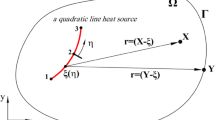Abstract
Devices are described which make it possible to adapt existing models for a continuousmode solution of both linear and nonlinear reverse transient-heat-conduction problems with variable boundary conditions.
Similar content being viewed by others
Literature cited
L. A. Kozdoba, Reports of the Fifth International Conference on Physics and Mathematical Simulation, Thermoenergetics Section [in Russian], MEI, Moscow (1968).
V. E. Prokof'ev, Inzh.-Fiz. Zh.,18, No. 1 (1970).
O. N. Suetin, O. T. Il'chenko, and V. E. Prokof'ev, in: Power-Machinery Construction [in Russian], No. 9, KhGU, Khar'kov (1970).
Yu. M. Matsevityi and V. E. Prokof'ev, Inzh.-Fiz. Zh.,20, No. 2 (1971).
N. S. Nikolaev, E. S. Kozlov, N. P. Pologorodnik, The USM-1 Analog Computer [in Russian], Mashgiz, Moscow (1962).
Yu. V. Vidin, Izv. Akad. Nauk SSSR, Energetika i Transport, No. 3 (1967).
Author information
Authors and Affiliations
Additional information
Translated from Inzhenerno-Fizicheskii Zhurnal, Vol. 22, No. 2, pp. 310–316, February, 1972.
Rights and permissions
About this article
Cite this article
Prokof'ev, V.E. Solving reverse transient-heat-conduction problems by electrical simulation. Journal of Engineering Physics 22, 218–221 (1972). https://doi.org/10.1007/BF00825906
Received:
Issue Date:
DOI: https://doi.org/10.1007/BF00825906




